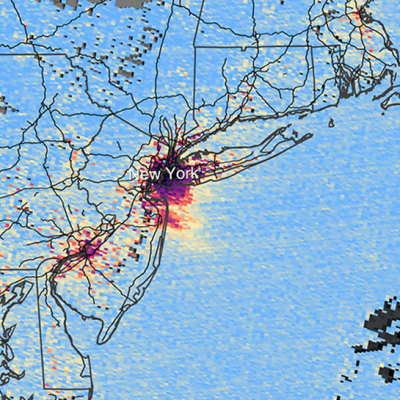After years of estimating global mean sea level from tide gauge readings, scientists are now getting the high quality satellite altimeter data they need to detect small but significant changes in sea level.
In a widely reported analysis of the first 2.5 years of NASA's Physical Oceanography Distributed Active Archive Center (PO.DAAC)-distributed Topography Experiment (TOPEX)/Poseidon data, University of Texas researcher Steve Nerem found an average rise in global mean sea level of 5.8 mm per year from 1993 through 1995.
According to long-term averages estimated from tide gauge measurements, global mean sea level has been rising at a rate of only one to two millimeters per year over the last century. However, mean sea level changes over shorter time scales are more difficult to detect using tide gauges. The rise observed by TOPEX/Poseidon was undetectable using tide gauge data.
Tide gauge data have been venerable but imperfect indicators of variations in global mean sea level. The gauges are few and far between, and are always at the edge of the land. Moreover, rather than measuring absolute sea level change, tide gauges measure the height of the sea surface relative to crustal reference points that may move with tectonic activity or local subsidence.
The TOPEX/Poseidon altimeter not only measures absolute sea level relative to the Earth's center, it also provides much greater spatial coverage than tide gauges. "Having a satellite like TOPEX/Poseidon is equivalent to having half a million tide gauges out around the ocean," Nerem says.
Though TOPEX/Poseidon solves the coverage problem, Nerem and his colleagues still had to address a multitude of error sources to establish that the observed rise was in fact real. They corrected orbits, considered whether the corrections affected the measurements, and examined the possibility that the instrument drifted during the mission.
"Because the expected rise of global mean sea level is only a few millimeters a year, we pushed the capabilities of the instrument to the maximum," he says. "With a satellite flying at an altitude of 1,336 kilometers, it's very much a challenge to work at the millimeter level."
Once they were confident that what they were seeing represented real sea level variation, Nerem and his colleagues began looking for its possible causes. After spotting a fairly strong correlation between global sea surface temperatures and the observed sea level rise, they had a suspected culprit.
"We think that the rise is probably wrapped up in some natural variability of global sea surface temperatures that occurs on something like interannual to decadal scales," Nerem says.
To explore the possibility that climate change is responsible for the observed sea level rise, scientists need a much longer time-series of high quality altimeter data. Such an investigation of global mean sea level would require a total of six to 10 years of data, Nerem suggests, and much more to determine its geographic variation. This requirement pushes the limits of the instrument in another way. TOPEX/Poseidon was launched in August 1992 with a life expectancy of only three years.
More than three-and-a-half years later the satellite continues to perform well. However, Nerem and the many other U.S. and French investigators doing similar work with TOPEX/Poseidon data follow its progress closely. Every day, Nerem checks the satellite's status report. "Every time it has a little hiccup, we all hold our breath," he says.
If TOPEX/Poseidon fails before an altimeter capable of producing data of comparable quality is launched, Nerem and the other investigators will have to contend with the resulting data gap. "If there's a gap, overcoming it will be a research problem in itself," he says.
Nerem would someday like to identify the reasons for the sea level variations and is cautiously optimistic about his prospects. "We're pinning our hopes on EOS ALT," he says about NASA's Earth Observing System altimeter mission scheduled for launch in 1999. "Until a future altimeter mission that overlaps with TOPEX/Poseidon is up and working though, we can't count on anything."
References
Nerem, R. S. 1995. Global mean sea level variations from TOPEX/POSEIDON altimeter data. Science. 268:708-10.
For more information
NASA Physical Oceanography Distributed Active Archive Center (PO.DAAC)
Ocean Topography Experiment (TOPEX)/Poseidon
| About the remote sensing data used | ||
|---|---|---|
| Data | TOPEX/Poseidon | |
| Parameter | sea level rise | |
| DAAC | NASA Physical Oceanography Distributed Active Archive Center (PO.DAAC) | |
